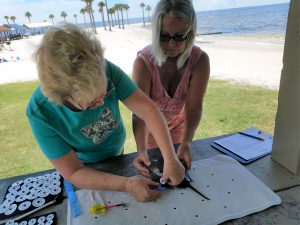Crabs have 10 legs. Spiders have eight legs. Insects have six legs. All basic biological facts we learned back in elementary school, right?
However, scientists at the University of Wisconsin-Madison say that 10-legged horseshoe crabs aren’t crabs at all! Recent genetic analysis confirmed that horseshoe crabs are relatives of arachnids (e.g., spiders and scorpions). Moreover, horseshoe crabs are living fossils that benefit humans and coastal communities.
When the tides and moon are just right during the spring and fall months, horseshoe crabs can be spotted nesting along Hernando’s coastal ecosystems. Using specialized claws, male horseshoe crabs attach to larger female horseshoe crabs to form a temporary bond. Together, the pair burry fertilized eggs in the sandy, inter-tidal areas of the marshes and beaches. After several weeks, horseshoe crab larvae emerge, and they spend most of life on the bottom of inter-tidal flats.
Besides being a popular prey item for many fish, birds, and sea turtles, horseshoe crab’s unique blue blood is used by pharmaceutical companies to ensure intravenous drugs are free of harmful bacteria. “Limulus Amebocyte Lysate”, a substance found in the blood, clumps when bacterial toxins are present allowing for sterility of medical equipment and injectable drugs to be tested.
To better understand horseshoe crab movements and population numbers, the University of Florida has partnered with the FWC Fish and Wildlife Research Institute to create the Florida Horseshoe Crab Watch Program. For this program, volunteers survey coastal shorelines for mating horseshoe crabs. A subset of the crabs is then collected, tagged, and released back into the wild.
If you are interested in participating in the Florida Horseshoe Crab Watch Program, the UF/IFAS Extension Hernando County Office will be holding a training workshop on September 13, 2019. To register, please visit:
https://www.eventbrite.ca/e/horseshoe-crab-citizen-science-training-2019-tickets-65694641441
You can also help us collect data on nesting horseshoe crabs by reporting the tagged animals. The steps are simple:
1) Snap a picture of the tag or record the tag number
2) Note the date, location, and general condition of the crab
3) Report the data using the online form (www.fws.gov/crabtag) or by calling 1-888-546-8587

 0
0
